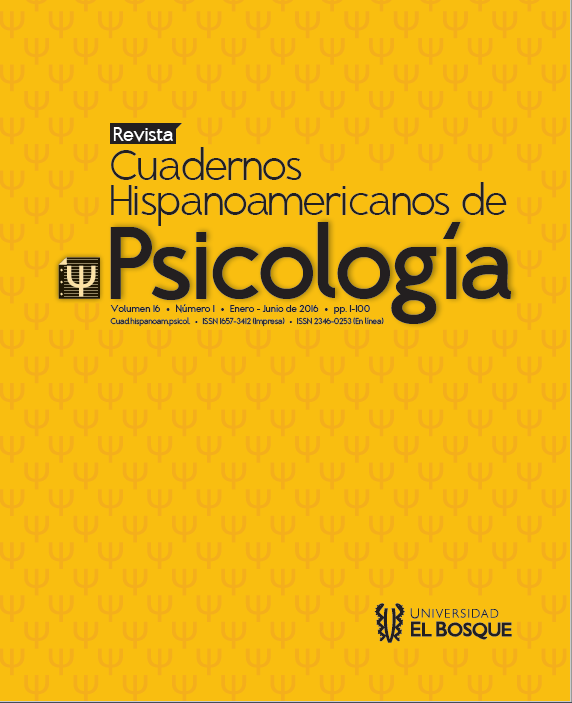1. Analysis of the Eating Attitudes Test (EAT-26) through a Rasch Model in a sample of Paraguayan Adolescents
DOI:
https://doi.org/10.18270/chps..v16i1.2665Palabras clave:
Trastornos alimenticios, Modelo de Rasch, Modelo de Escalas de Calificación, Test de Actitudes AlimentariasResumen
Although the EAT-26 is a test widely used worldwide in the diagnosis and research of eating disorders, there are hardly any studies of its psychometric properties using Rasch Model (RM). The first objective of this study was to analyze with the Rating Scale Model, an extension of RMl for polytomous ítems, EAT-26 test on a sample of adolescents. The second objective was to propose an adaptation of the EAT-26 for its use in the Paraguayan context. Collapsing the 6 original categories and eliminating items that do not fit the model, a version of the EAT -with 18 items and 3 response categories- was proposed. The results for the characteristics of the new version are provided: unidimensionality, fit to the model of people and items, reliability, differences in scale between men and women and differential item functioning related with sex.
Descargas
Referencias bibliográficas
Baldares, M. J. V. (2013). Trastornos de la Conducta Alimentaria. Revista Médica de Costa Rica y Centroamérica, 70(607), 475–482.
Benjamini, Y., Hochberg, Y. (1995). Controlling the false discovery rate: a practical and powerful approach to multiple testing. Journal of the Royal Statistical Society. Series B (Methodological), 57(1), 289-300.
Chou, Y.-T., & Wang, W.-C. (2010). Checking Dimensionality in Item Response Models With Principal Component Analysis on Standardized Residuals. Educational and Psychological Measurement, 70(5), 717-731. http://doi.org/10.1177/0013164410379322
Constaín, G. A., Ricardo, C., Rodríguez-Gázquez, M. A., Álvarez M., Marín, C., & Agudelo, C. (2014). Validez y utilidad diagnóstica de la escala EAT-26 para la evaluación del riesgo de trastornos de la conducta alimentaria en población femenina de Medellín, Colombia. Atención Primaria, 46(6), 283-289. http://doi.org/10.1016/j.aprim.2013.11.009
Evers, A., Hagemeister, C., Hostmaelingen, A., Lindley, P., Muñiz, J., & Sjöberg, A. (2013). EFPA Review Model for the description and evaluation of psychological and educational tests. Test review form and notes for reviewers. Version 4.2. 6. Brussels: European Federation of Psychology Associations. Recuperado a partir de http://www.academia.edu/download/38683296/
Fernández, L., & Erro, G. (2004). Trastornos de la alimentación: de la evaluación al tratamiento, Madrid: UNED Ediciones.
Garner, D. M., & Garfinkel, P. E. (1979). The Eating Attitudes Test: an index of the symptoms of anorexia nervosa. Psychological Medicine, 9, 273-279.
Garner, D. M., Olmsted, M. P., Borhr, Y., & Garfinkel, P. E. (1982). The Eating Attitudes Test: psychometric features and clinical correlates. Psychological Medicine, 11, 871-878.
Gouveia, V. V., de Lucena Pronk, S., Santos, W. S., Gouveia, R. S., & Cavalcanti, J. P. (2010). Test de Actitudes Alimentarias: Evidencias de Validez de una Nueva Versión Reducida. Interamerican Journal of Psychology, 44(1), 28–36.
Linacre, J. M. (2002). Optimizing rating scale category effectiveness. Journal of Applied Measurement, 3(1), 85–106.
Linacre, J. M., & Wright, B. D. (2011). A user’s guide to WINSTEPS: Rasch-model computer program. Chicago: Mesa Press.
Maïano, C., Morin, A. J. S., Lanfranchi, M.-C., & Therme, P. (2015). Body-related Sport and Exercise Motives and Disturbed Eating Attitudes and Behaviours in Adolescents: Body-Related Sport and Exercise Motives. European Eating Disorders Review, 23(4), 277-286. http://doi.org/10.1002/erv.2361
Miguel, J. P., Silva, J. T., & Prieto, G. (2013). Career Decision Self-Efficacy Scale — Short Form: A Rasch analysis of the Portuguese version. Journal of Vocational Behavior, 82(2), 116-123. http://doi.org/10.1016/j.jvb.2012.12.001
Montero, I., León, O. G. (2007). A guide for naming research studies in Psychology. International Journal of Clinical and Health Psychology, 7(3), 847-862.
Mora-Simón, S., García-García, R., Perea-Bartolomé, M. V., Ladera-Fernández, V., Unzueta-Arce, J., Patino-Alonso, M. C., & Rodríguez-Sánchez, E. (2012). Deterioro cognitivo leve: detección temprana y nuevas perspectivas. Revista de Neurología, 54(5), 303–310.
Muñiz, J. (2010). Las teorías de los tests: teoría clásica y teoría de respuesta a los ítems. Papeles del psicólogo, 31(1), 57–66.
Nunes, M. A., Camey, S., Olinto, M. T. A., & Mari, J. de J. (2005). The validity and 4-year test-retest reliability of the Brazilian version of the Eating Attitudes Test-26. Brazilian Journal of Medical and Biological Research, 38(11), 1655–1662.
Orbitello, B., Ciano, R., Corsaro, M., Rocco, P. L., Taboga, C., Tonutti, L., Balestrieri, M. (2006). The EAT-26 as screening instrument for clinical nutrition unit attenders. International journal of obesity, 30(6), 977–981.
Pineda, D. A., Guerrero, O. L., Pinilla, M. L., & Estupiñán, M. (2002). Utilidad de un cuestionario para rastreo del estrés postraumático en una población colombiana. Revista de Neurología, 34(10), 911–6.
Portela de Santana, M. L., da Costa Ribeiro Junior, H., Mora Giral, M., & Raich, R. (2012). La epidemiología y los factores de riesgo de los trastornos alimentarios en la adolescencia: una revisión. Nutrición hospitalaria, 27(2), 391–401.
Prieto, G., & Delgado, A. R. (2003). Análisis de un test mediante el modelo de Rasch. Psicothema, 15(1), 94–100.
Prieto, G., & Delgado, A. R. (2007). Measuring math anxiety (in Spanish) with the Rasch rating scale model. Journal of applied measurement, 8(2), 149.
Prieto, G., & Nieto, E. (2014). Influence of DIF on Differences in Performance of Italian and Asian Individuals on a Reading Comprehension Test of Spanish as a Foreign Language. Journal of applied measurement, 15(2), 176–188.
Prieto, G., & Velasco, A. (2003). Uso del modelo de Rasch para poner en la misma escala las puntuaciones de distintos tests. Actualidades en psicología, 19(106), 5–23.
Rasch, G. (1960). Probabilistic models for some intelligence and attainment tests. Copenhagen, Denmark: Danish Institute for Educational Research.
Wright, B. D., & Douglas, G. A. (1976). Rasch item analysis by hand. Statistical Laboratory Department of Education Univ Chicago.














